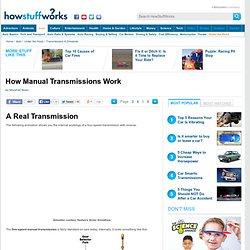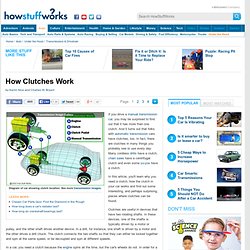

Universal Joint. Propeller Shaft. Phasing. The Gearbox. Synchromesh. Dog Leg. The following animation shows you the internal workings of a four-speed transmission with reverse.

<span style="font-weight:bold;font-size:85%;"> Your browser does not support JavaScript or it is disabled. </span> Animation courtesy Geebee's Vector Animations The five-speed manual transmission is fairly standard on cars today. Internally, it looks something like this: There are three forks controlled by three rods that are engaged by the shift lever. Keep in mind that the shift lever has a rotation point in the middle. You can see that as you move the shifter left and right you are engaging different forks (and therefore different collars). Reverse gear is handled by a small idler gear (purple). Synchronizers Manual transmissions in modern passenger cars use synchronizers to eliminate the need for double-clutching. The cone on the blue gear fits into the cone-shaped area in the collar, and friction between the cone and the collar synchronize the collar and the gear. Constant mesh gearbox.
Sliding mesh gearbox.
GCSE Bitesize: Gears: 1. Gear Ratio and Velocity Ratios - Basics. Clutch Faults. Clutch. If you drive a manual transmission car, you may be surprised to find out that it has more than one clutch.

And it turns out that folks with automatic transmission cars have clutches, too. In fact, there are clutches in many things you probably see or use every day: Many cordless drills have a clutch, chain saws have a centrifugal clutch and even some yo-yos have a clutch. In this article, you'll learn why you need a clutch, how the clutch in your car works and find out some interesting, and perhaps surprising, places where clutches can be found. Clutches are useful in devices that have two rotating shafts. In these devices, one of the shafts is typically driven by a motor or pulley, and the other shaft drives another device. In a car, you need a clutch because the engine spins all the time, but the car's wheels do not. To understand how a clutch works, it helps to know a little bit about friction, which is a measure of how hard it is to slide one object over another.